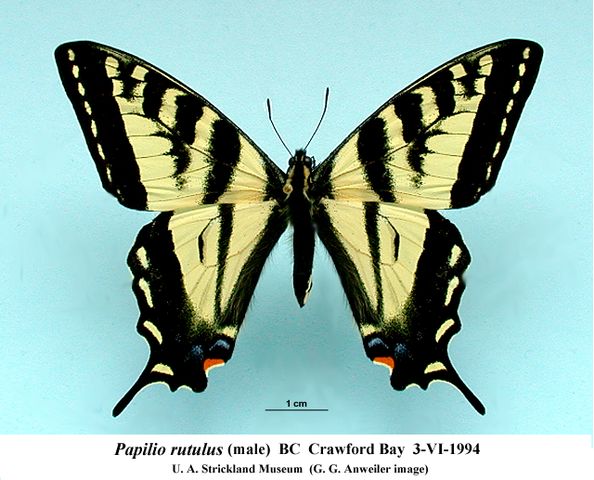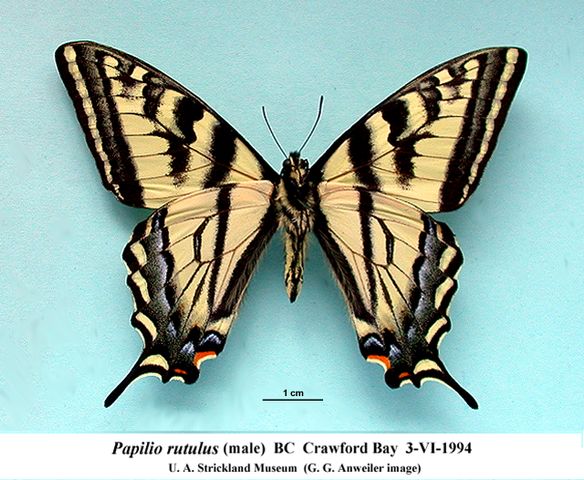« Back to your search
Species Details
Papilio rutulus
University of Alberta E.H. Strickland Entomological Museum Read more about this collection »
Common NameWestern Tiger Swallowtail
SeasonalityOne yearly flight, peaking in June.
IdentificationIn Alberta, this species is likely to be encountered only in the southern mountains south of the Crowsnest Pass, where the very similar Canadian Tiger Swallowtail (P. canadensis) also flies. The Western Tiger has yellow rather than red crescents along the margin of the hindwing underside, has a thicker black cap to the orange spot in the hindwing anal spot, and has a predominantly black rather than yellow forewing fringe.
Scientific Name
Papilio rutulus
Common Name
Western Tiger Swallowtail
Habitat
Montane woodlands and along water courses.
Seasonality
One yearly flight, peaking in June.
Identification
In Alberta, this species is likely to be encountered only in the southern mountains south of the Crowsnest Pass, where the very similar Canadian Tiger Swallowtail (P. canadensis) also flies. The Western Tiger has…
In Alberta, this species is likely to be encountered only in the southern mountains south of the Crowsnest Pass, where the very similar Canadian Tiger Swallowtail (P. canadensis) also flies. The Western Tiger has yellow rather than red crescents along the margin of the hindwing underside, has a thicker black cap to the orange spot in the hindwing anal spot, and has a predominantly black rather than yellow forewing fringe.
Life History
The eggs are smooth, green and round, laid singly on the host plant (Pyle 2002). Mature larvae are velvety green with a pair of yellow-rimmed eyespots and a yellow stripe on the mid-thoracic segment (Pyle 2002). The…
The eggs are smooth, green and round, laid singly on the host plant (Pyle 2002). Mature larvae are velvety green with a pair of yellow-rimmed eyespots and a yellow stripe on the mid-thoracic segment (Pyle 2002). The tan and brown-streaked pupa overwinters (Pyle 2002). This species tends to have an extended emergence period and a longer lifespan than smaller species (Pyle 2002).
Conservation
Not of concern.
Diet Info
The Adults are avid flower visitors and males often mud-puddle (Guppy & Shepard 2001). Larvae feed on a variety of shrubs in B.C., including alder, apple, birch, cherry, poplar and willows (Guppy & Shepard 2001).
Range
Ranges from southern BC south throughout the western US (Opler 1999). The first confirmed Alberta specimen of this species was collected by Ted Pike in the Castle River region in 2002 (B.C. Schmidt, unpubl. data).
References
Author
Opler, Paul A.
Title
A field guide to western butterflies.
Publication Date
1999
Pages
540
Author
Guppy, Crispin S. and Jon H. Shepard
Title
Butterflies of British Columbia.
Publication Date
2001
Pages
414
Author
Pyle, R. M.
Title
Butterflies of Cascadia
Publication Date
2002
Specimen Information
There are 24 specimens of this Species.






